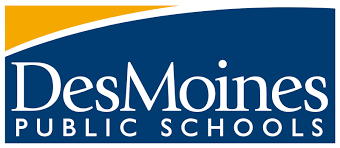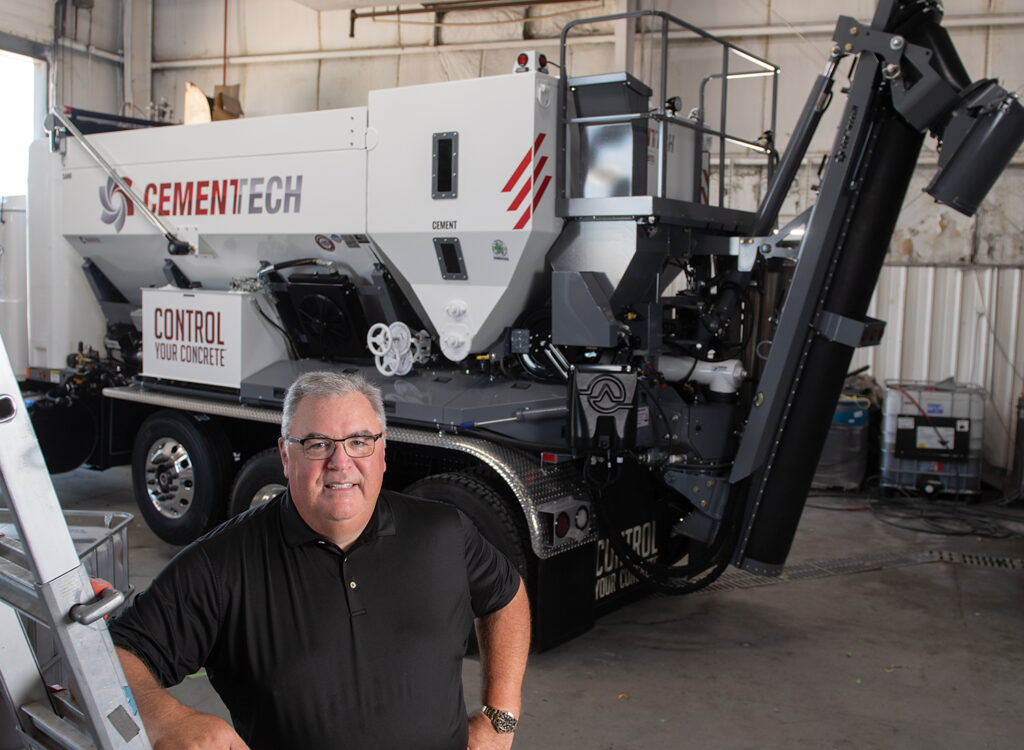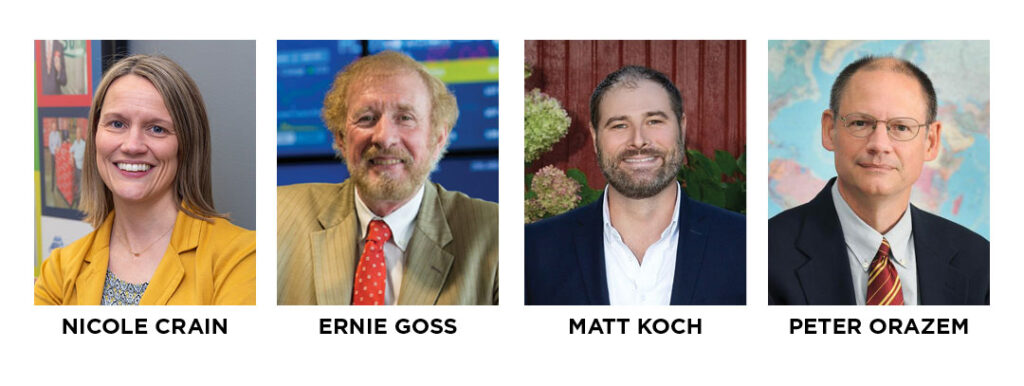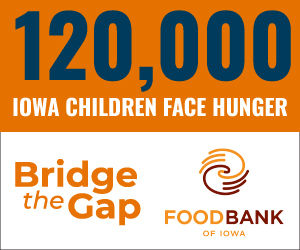A Closer Look: Ryan Osborn
president, Junior Achievement of Central Iowa

When Ryan Osborn reflects on his first 18 months as president of Junior Achievement of Central Iowa, he naturally looks up at the organization’s dry ceiling, now protected by a new roof that was donated last summer. Osborn, who became JA’s president in October 2016 after six years as director of advancement for Dowling Catholic High School, has led the nonprofit to firmer financial footing as well, and is now taking steps to expand JA’s program offerings for Central Iowa students. Its newest program, JA Finance Park, is slated to begin next fall with the 2018-19 school year. Osborn said an important role of JA is to serve as the bridge between schools and businesses in helping students prepare for future careers. In his younger days, Osborn traveled throughout Europe and lived for a time in Rome; now he stays close to home to be with his wife and two toddlers.
Was it a big adjustment going from school administration to this nonprofit?
There are certainly a lot of similarities between the jobs — it was very much a nonprofit role I had at Dowling, too, doing things like raising money. I had a department I was in charge of there that was about the same size as the staff here. Probably the biggest difference here is that we have a pretty big board that I work with, and I’m working more in a direct capacity with the board than I was at Dowling. … We have close to 30,000 students that participate in Junior Achievement each school year. So the impact that we can make is significant with the number of students we’re serving.
What have some of the highlights been from your first year and a half?
It’s probably not the shiniest project, but the one that comes to my mind is that we had a new roof put on here at Junior Achievement, and we actually had that all donated. Last summer four roofing competitors came together, and they combined to provide the services, labor and materials. From my understanding, it was probably something that needed to be done 15 years ago, but we just keep putting a [bandage] on it until that wouldn’t work anymore. It was leaking when we had students coming through BizTown {the hands-on learning program}, and we just couldn’t continue operating that way anymore. That was a big issue for us, because we didn’t have the money to put in a new roof. We didn’t have enough money to fund our current programs, let alone $100,000-plus to fund a new roof. For those programs to come together on that was just a huge gift for us.
How are the organization’s finances looking now?
On the fundraising side, we did reach a surplus this past year. A number of years prior, we were actually operating in a deficit. We’ve had some challenges over the years, but hopefully we’ve turned a corner last year where we’re setting up for more of a sustained financially healthy model as we go forward.
Was there something in particular that helped get into the black?
I think probably the biggest thing that helped us get fundraising numbers up was individuals. For a long time, Junior Achievement has gotten great support from the corporations in town, but the individual donor community has been relatively few people. … That was wonderful to see [that change]. I worked hard with my board, and they really stepped up in a big way to make some personal gifts, and I think that allowed us to go out to other generous philanthropic people in the community. I think that increase in personal giving was really the difference-maker for us.
What are the big fundraising events?
We have three special events; the biggest one is our golf outing. The JA Golf Classic has been going on for a couple of decades. We have about a $900,000 budget; that event raises about $250,000, so it’s huge for us. That rotates each year between the three major clubs, so last year we were at Wakonda and this year we’re at Des Moines Golf and Country Club and next year we’ll be at Glen Oaks. In the fall, we have a bowlathon, and that’s a real fun event — it’s a real low-entry event, about $100 per team. A lot of people will use it as a department or team outing for their company. Coming up in the spring is our JA Stock Market Challenge — this will be the 11th year we’re doing that. It’s a sponsored event. The high school competition is in the morning, and in the evening we have a corporate challenge. The teams with the highest ending portfolios win.
What’s the status of the planned financial literacy program (JA Finance Park)?
That’s still No. 1 on our dream list. We were actually scheduled to pilot that this spring. However, our “point guard” for that is leaving, and we didn’t want to put the team on the field without the point guard. So we’ve postponed that pilot until next school year. We’ve done our research in terms of how many tablets we need to buy, the software and curriculum to purchase. The goal is to pilot that next school year and then build it from there. We’ll start small and responsibly grow it. Maybe next year we’ll start it with 100 kids and then the year after quadruple that.
How will that program be formatted?
It’s really about, how do you get kids to live within their means? You give them a scenario; they might be a single dad making $30,000 a year. At each stop, they have to make a decision, such as buying the brand-name product or the generic at the grocery store. Or are you going to buy a house or rent an apartment? And at the end, did they balance their budget and save a little bit? It’s proven to be a really powerful program at other Junior Achievements across the country in terms of the results and learning experiences they have.
Are you getting sufficient business interest for that program?
Definitely more work needs to be done. My first year, we were really focused on keeping our current programs running. Once we get that on a firm footing, then we’ll build on with the JA Finance Park. The few conversations I’ve had have been positive, and I think there’s a real appetite for a program like that, not only on the school side, but I think the businesses, too, see the value in it. We’re on the cusp of kicking off a campaign for it soon. We want to have a pilot where we can invite business folks to come and see it take place this coming school year.
What other goals do you have this year?
The big goal to finish off this school year is that we’re trying to reach 29,000 students. Last year we were a little over 28,000. About 6,500 students will go through JA BizTown; the remainder will actually have Junior Achievement in the classroom.
How is technology changing JA’s programs?
Historically, we have a business professional go in to actually teach Junior Achievement in the classroom, so you’re a real person in the real world with a real job who can get in front of the students. To do that, we had always provided that volunteer with what we call a volunteer kit. I call it a bag of magic with everything you need — the program materials, handouts, the playbook. Over these past couple of years, our middle school and high school programs have gone through an evolution where we’ve looked at how to deliver that model digitally. We call it our blended-learning model. So instead of sending in the volunteer with handouts, we’re actually using a smartboard or a tablet, or they’re going to be asking the kids to open up their laptops. That program will be delivered in a PowerPoint or in a video or other digital format, which I think is very exciting. It’s also a challenge, because we have to convince our longtime volunteers that may have been teaching the kit for 20 years or more to now teach it digitally.
We have our traditional programs delivered in the classroom by a volunteer. We have our capstone programs offered at JA BizTown. A third way to deliver our programs is something we call R&D programs. That deals with something we have heard about locally that people want us to provide, if it fits within our three core competencies — financial literacy, entrepreneurship and work readiness. Oftentimes, the teacher in the school isn’t willing to take on those learning experiences, so they’ll come to someone like us for help. In fact, the JA Stock Market Challenge was developed out of [the R&D program] about 11 years ago. I think the next big wave in the R&D program that I’m seeing is this whole topic of work readiness. How do you connect businesses with schools; how do you bridge that gap between the two? We want to continue developing R&D programs that are customized to what our local market here in Central Iowa is looking for.
Do you still get a chance to travel?
Considering I have a 4-year and a 3-year-old at home, not much recently. The traveling I’ve done has been primarily for work, or if we have an out-of-town wedding to go to. But no crazy travel adventures to report as of late. My 4-year-old son just started preschool, and my little girl will be in preschool next year. They’re only 19 months apart, so they’re the best of friends and the worst of enemies, depending on how full the moon is that day.
Any hobbies you’re into?
I actually got into a rec basketball league this winter after I ran into a guy I used to play basketball with. The funny thing about it is it’s 7 a.m. on Saturday mornings, because a lot of the guys who play in it have kids, too. So you get up early, get your game in, and you can still get back home to help with Saturday morning breakfast. I love golf, and I’m looking forward to it warming up. And I’ll be coaching T-ball for the first time this summer.









